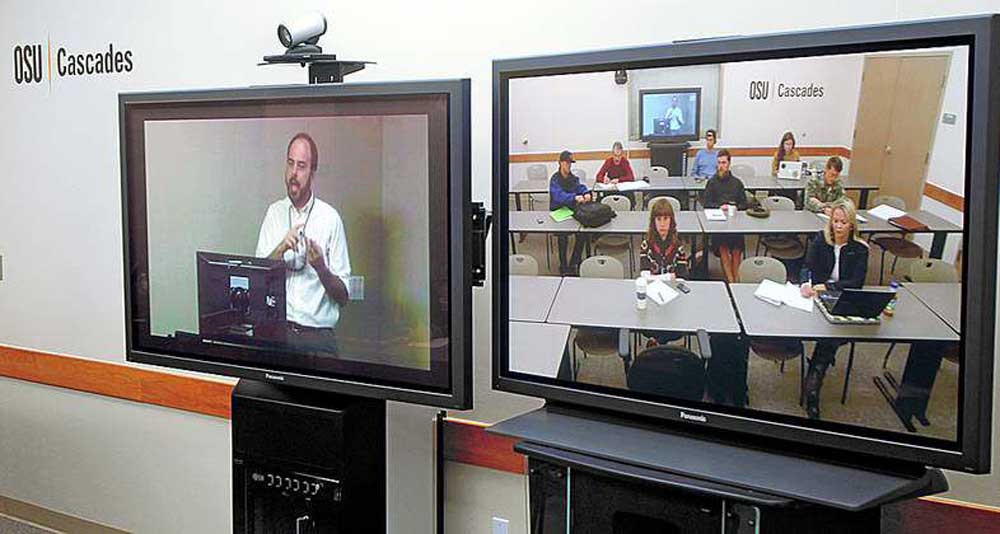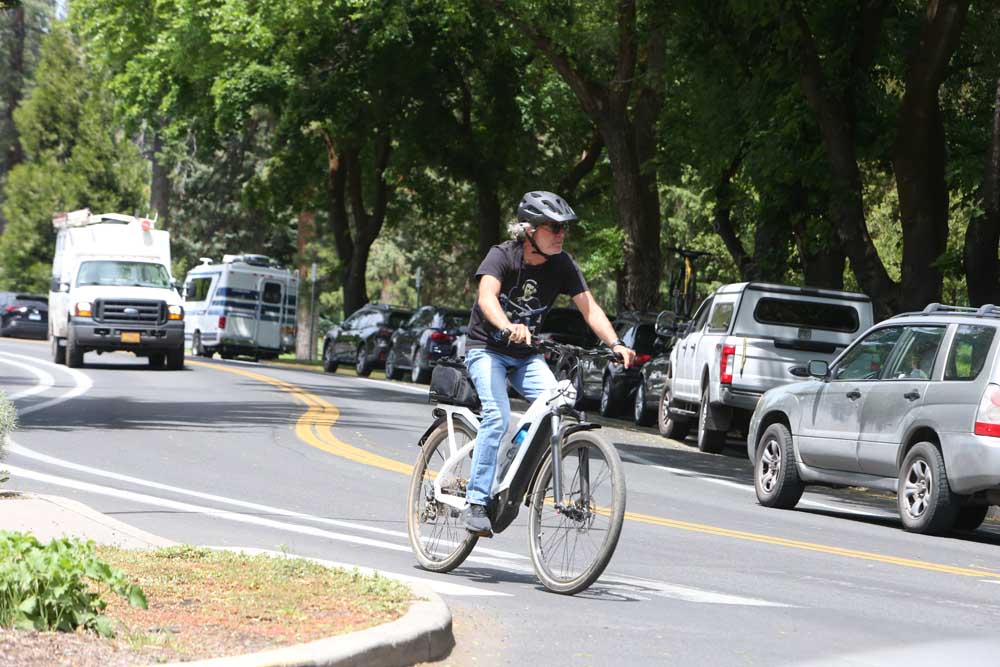OSU-Cascades’ digital instruction
Published 5:00 am Sunday, October 20, 2013

- Oregon State University professor John Bailey, pictured on the left screen, delivers a lecture Thursday in Corvallis that is transmitted to a classroom for students attending an OSU-Cascades class, shown on the right screen, at the Central Oregon Community College campus in Bend.
In an Oregon State University-Cascades Campus section of Wildland Fire Science and Management on Thursday, students discussed the end to the government shutdown as their professor tried to get ready.
But the task for OSU associate professor John Bailey was more complicated than finding a piece of chalk — the feed connecting his image and voice from OSU’s main campus in Corvallis to a large flat screen in Bend wasn’t quite working. Color bars appeared intermittently and sometimes the screen went black. After about five minutes and a visit from the IT department, both sides could see each other.
“Oh, you guys look great,” Bailey joked to his Bend students as the two-way audio-visual connection stabilized.
A traditional “hybrid” course contains a mix of direct and online instruction, but Bailey’s course offers the added twist of a live-stream transmission that allows him to teach the class remotely.
Overall, there are three cohorts of students, one in Bend, one in Corvallis and an “Ecampus” group focused on Internet instruction that is literally spread across the world. The university has plans to grow its hybrid and transmission offerings as a means to provide its growing student body with more variety. Of approximately 200 OSU-Cascades courses a year, about five are transmitted and 10 use a hybrid approach.
“These students get an experienced OSU forestry professor, and that department is sort of the Yankees of forestry,” said OSU-Cascades Communications Director Christine Coffin. “Hiring our own faculty is something we want to do right, and that takes time. Hybrid classes allow us to grow sustainably as we can bring in quality professors without having to bring someone fresh into the OSU world.”
Two university classrooms at Cascades Hall on the Central Oregon Community College Campus have video-conferencing technology, including a series of microphones that allow students in all corners of the room to ask questions. At the university’s Graduate and Research Center on Colorado Avenue, a mobile video-conference system can travel from one class to another.
The university offers instructors training for hybrid and distance-learning, but as Bailey himself admits, managing the technology involved while also adjusting one’s pedagogy can be challenging.
“An analogy may be the added work required to go out of your way to pick up extra kids to take to the football game,” Bailey said. “It’s more work, but you have more personalities in the car and at the game, and that’s what matters.”
Bailey’s students had complaints a few weeks in, but overall remained optimistic.
“The first week was pretty good,” said Allan Sanford, 48, a student in the natural resources program. “But the last two weeks it’s been kind of bad. One day, he couldn’t hear us.”
Michale Slater, a 26-year-old in the same program, complained that “sometimes he doesn’t see you raise your hand.” Despite the issues, both students said they are happy with the class overall, emphasizing that it is an improvement over a strictly online course, the other path open into Bailey’s course.
Bailey is eager to hear the criticisms, and acknowledged that, on average, his students in Corvallis seem somewhat more engaged than his distance-learners. One of the issues is the tiny lag time that accumulates as voices and faces travel between the campuses.
“Something I worry about, and we’ve talked about, is making sure the Bend students feel comfortable speaking up, even though it may be awkward or they feel like they’re interrupting,” Bailey said. “With so much more to pay attention to, I can get rolling and miss something. But we’re on the leading edge with this course.”
Bailey said he embraces the challenges, and sees them as a way to make this format better.
“There is a challenge but also a fascination to it,” he said. “It’s something that has to be done, the need is there, and someone needs to test it and work the kinks out. We’ll work to smooth the kinks out and find what works in order to build a critical mass of people doing it who can share ideas.”
The fusion of online with face-to-face instruction adds an additional dynamic to Bailey’s class with its own opportunities and challenges.
“Nobody needs to sit in a classroom and just simply hear a lecture these days,” said Becky Johnson, an OSU vice president and the highest ranking administrator at OSU-Cascades. “Now students can more often meet in small groups and really interact with the professor during class time.”
Ron Reuter, an OSU-Cascades associate professor of natural resources, reinforced this sentiment.
“We don’t waste student and instructor time by showing up to class and then watching a video that they could have watched from the comfort of their house and have them fall asleep in the classroom,” Reuter said, referencing his own hybrid courses. “With the availability of media in this age, face-to-face time should be better used for discussion and debate rather than watching a video. In the long run, the university can make more efficient use of time and space.”
Reuter also noted how courses with online components are more flexible, as some of the class time is replaced by self-directed work. Because of this, Reuter said, students “can commit to a work schedule if they need financial support and take care of the online component when that fits their schedule.”
Still, students in Bailey’s class said they were wary of courses that overemphasize online instruction.
“I like being able to talk and ask questions and actually be in a classroom,” Slater said.
Marla Hacker, OSU-Cascades’ associate dean of academic programming, said that while the university is training more and more professors in hybrid education, the traditional classroom will continue to be the dominant mode of instruction.
“There’s still a large number, a majority even, that really want and need classroom learning,” she said. “The cool thing is that higher education is starting to realize that there are different learning preferences, just like in other areas, people want more choices.”
Hacker said the university’s efforts at training faculty in hybrid teaching does not signal a sea change, but is merely meant to provide teachers with more skills.
“We’re just starting to retool the faculty in this new way of teaching so that they may apply it where appropriate,” she said. “It won’t be across the board, but it increases their toolbox of teaching.”






